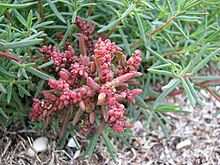Suaeda australis
Appearance
| Suaeda australis | |
|---|---|

| |
| Scientific classification | |
| Kingdom: | Plantae |
| Clade: | Tracheophytes |
| Clade: | Angiosperms |
| Clade: | Eudicots |
| Order: | Caryophyllales |
| Family: | Amaranthaceae |
| Genus: | Suaeda |
| Species: | S. australis
|
| Binomial name | |
| Suaeda australis (R.Br.) Moq.[1]
| |
| Synonyms | |
| |

Suaeda australis, the austral seablite, is a species of plant in the family Amaranthaceae, native to Australia. It grows to 10 to 90 cm (4 to 35 in) in height, with a spreading habit and branching occurring from the base. The leaves are up to 40 mm in length and are succulent, linear and flattened.[2][3] They are light green to purplish-red in colour.[4]
The species occurs on shorelines in coastal or estuarine areas or in salt marshes. It is native across Australia including the states of Queensland, New South Wales, Victoria, Tasmania, South Australia and the south-west of Western Australia.[2]
In irrigated areas, the species is known as a salinity indicator plant and is referred to as redweed.[5]
References
[edit]- ^ "Suaeda australis". Australian Plant Name Index (APNI), IBIS database. Centre for Plant Biodiversity Research, Australian Government.
- ^ a b Jacobs, S.W.L. "New South Wales Flora Online: Suaeda australis". Royal Botanic Gardens & Domain Trust, Sydney, Australia.
- ^ "Suaeda australis". FloraBase. Western Australian Government Department of Biodiversity, Conservation and Attractions.
- ^ "Suaeda australis". Electronic Flora of South Australia Fact Sheet. State Herbarium of South Australia.
- ^ "Austral Seablite". Victorian Resources Online. Department of Primary Industries (Victoria).
External links
[edit]- Online Field guide to Common Saltmarsh Plants of Queensland
- Suaeda australis occurrence data from Australasian Virtual Herbarium
 Media related to Suaeda australis at Wikimedia Commons
Media related to Suaeda australis at Wikimedia Commons
